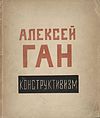The International Constructivist Faction
The concept of the Constructivist International was first proposed at the International Congress of Progressive Artists, held in Düsseldorf, 29-31 May 1922. [1] A few days prior to the Congress, the key actors involved in launching the KI, met together in Weimar: Theo van Doesburg, El Lissitzky, Hans Richter, Werner Graeff, Karl Peter Röhl and Cornelis van Eesteren. Although they did not develop a unified position, they did develop a shared view on organising avant-garde artists internationally in the interests of social transformation rather than simply aesthetic issues or the pragmatic issues of organising exhibitions, music festivals etc. [1]
During the first day, the Young Rhineland group presented their proposed proclamation, creating some dissent when they suggested that those who did not want to sign it should leave the congress.
This page is based on this
Wikipedia article Text is available under the
CC BY-SA 4.0 license; additional terms may apply.
Images, videos and audio are available under their respective licenses.

